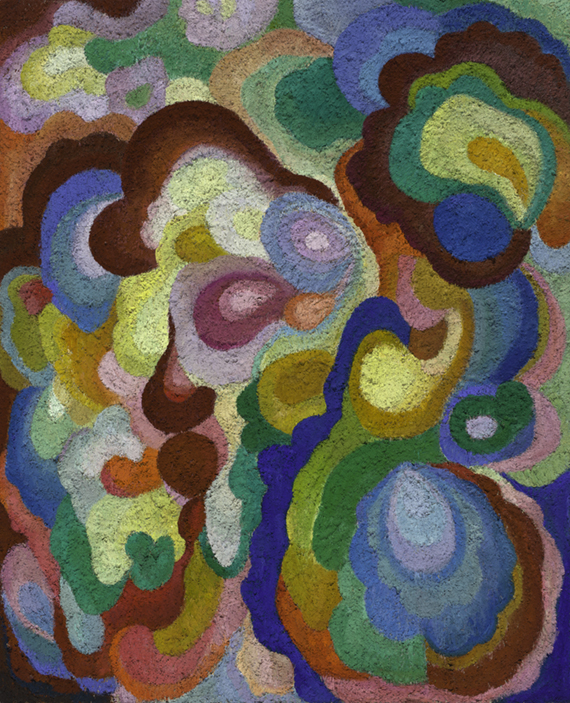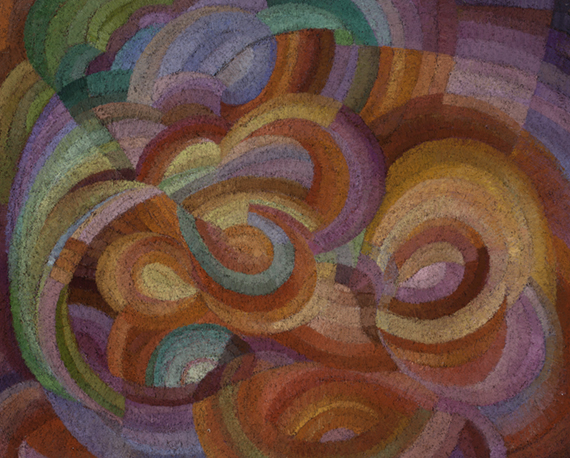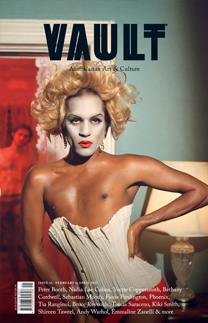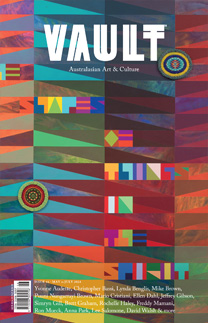Force from History: Yvette Coppersmith
Yvette Coppersmith may be best known as a portrait painter, but her aesthetic explorations include art history, biography, feminism, spirituality and harnessing change toward “what a future vision could be, and how to energise as a collective.”

Image credit: Yvette Coppersmith, Untitled Movement (Flowers), 2021-22, 81 x 66.5 cm, oil on linen. Photo: Matthew Stanton. Courtesy Sullivan+Strumpf
Yvette Coppersmith channels the energy of her many ideas in her body – and, when I meet her on Zoom, she looks both familiar and not, given the subject of her paintings is often herself. While she started as a realist painter, her mature compositions – with their built surfaces and constructed imagery – capture both personal and art history; in its visual references to Australian mid-century modernists, her work gathers a sensibility that appears timeless. Her self-portraits, notably the Archibald-winning Self Portrait after George Lambert (2018), convey this chameleon-like ability. She described her use of stylistic alter egos as “like an outfit slipped on, the image of an ever-changing self.”
In our conversation, Coppersmith’s thoughts and ideas travel across a distinctive field of interests and research. This trajectory evokes the movement conjured in the abstracted shapes dancing across paintings in her 2022 solo exhibition Presage, at Sullivan+Strumpf, Sydney. These sumptuous images are seductive and joyful, inviting the viewer to examine textured surfaces that read like intricate embroidery. Yet increasingly, at the heart of her work, with its ability to shift across figuration and abstraction, is an urgency that speaks to humanity’s dilemmas.
Coppersmith had early success as an artist, winning the inaugural Metro 5 Art Prize (Melbourne) in 2003, only two years after she had finished art school. However, “I knew that I needed time to experiment and explore. I didn’t want to be put in a box too soon. I needed to take time to develop my language. But ultimately, I’ve needed to find a gallery that understands that my language is not one particular thing. It will shift and evolve, and they have to be comfortable with whatever surprise I bring to the table.”
Coppersmith’s Presage is likely to have been one of those surprises. While it was her first solo exhibition since the Archibald Prize win in 2018 – which consolidated her reputation for portraiture and brought even more high profile commissions – it comprised mainly abstract paintings. Its title, Presage, suggests a looming darkness, but these images are bright, emotional assays, incorporating multiple references, historic and artistic, within their lyrical reach.
In 1939, the Original Ballet Russe performed Les Presages in Melbourne, inspiring a body of work by Australian abstractionist Roger Kemp. When the National Gallery of Victoria staged a Kemp retrospective in 2019, Coppersmith found its dance-inspired works transcendent – there was just so much “joy in the work.” She came away from Kemp’s exhibition feeling that she wanted to respond in a more feminine visual language. It took three years to gestate and resulted in the 2022 solo exhibition with Sullivan+Strumpf.
This attraction to modernism connects, for Coppersmith, with her grandparents’ survival of the Holocaust, which resulted in their move from Europe to Australia.
“I just thought, ‘It is so interesting that I love Kemp’s work – that’s what was happening in Melbourne, right before World War Two.’ There’s a correlation, with Presage produced on the brink of something else; we too are living through a tipping point. Yet to some degree we have an ability to mitigate the trajectory. Kemp saw the role of his work as elevating consciousness. And perhaps it’s timely to be envisioning some of that creative energy and aliveness. To think about what fuels change, whether it’s fear or love – the shift towards being inspired by a future vision, of what technologies offer us and how we might energise as a collective.”
Coppersmith drew on her early interests in performing and directing – being in front of and behind the camera – taking it further by engaging a composer who developed musical ideas for a score while she sketched, danced and made shapes using coloured silk lengths of fabric. “I needed to be the performer for this work, partly because I don’t know any ballerinas that I could call on. To be involved in the process in such an embodied way connects to my self-portraits and to my childhood love of ballet and costume,”
Coppersmith explains. “When I got the photos from photographer Bronwyn Kidd I thought, ‘Now I have to develop it into a visual language.’ I felt it needed to integrate the figurative and abstract.” Her ambition was to pair paintings with music to create an immersive art experience for the audience, “like some of the best gallery visits or concerts have given me, where I’ve come away feeling nourished and inspired.”
The paintings feature textured and matte surfaces, a consequence of Coppersmith’s processes of working with unresolved pieces. More recently, she has been using sand to create the sculptural and visually woven appearance of her surfaces. Their harmonies and colour palette speak in their atmospherics to the Australian modernists of the past – Grace Crowley, Roy de Maistre, Margaret Preston. The largest painting in the exhibition (Untitled Movement Triptych, 2022) includes figures, but the remainder take movement into energy, holding colour, light and shape in a tenuous balance. The accompanying soundtrack by Roslyn Orlando speaks to a balletic sensibility, a transcendent accompaniment. While Coppersmith describes herself as “pretty new to exhibiting abstraction,” her response was also to the spirit in Kemp’s work, with much of her research leading toward the theosophical movement in Europe and Australia, and its often-female leadership.
“Movement is the subject, either in abstract or figurative form. The colourful swirls of the silks connect to lyrical abstraction. They express embodied energy. Perhaps energetically, to support the movement of activism in a restorative way, we need beauty and joy. That is essential for the collective psyche as we doom-scroll our way through this decade.”
Coppersmith has incorporated abstract surfaces into her portraits and made abstract compositions for some years. For Presage, what is new is the emotive and immersive language, and the touchstone of movement and lyricism. As Goulburn Regional Art Gallery director Yvette Dal Pozzo suggests, “What makes Coppersmith’s abstract work feel so vital and relevant to audiences today is the artist’s ability to put so much of herself into the work, a skill honed throughout her acclaimed portraiture practice. Instead of representing a physical likeness, Coppersmith’s abstract works chart movements, moods and memories.”
Coppersmith describes portraiture as “one aspect of my practice. Things shift and I have a continual cycle of renewal as I move across style and subject matter.”
In recent years, she has wondered about connections between the self-portraits and her grandmother’s story of survival. “Of her immediate family, she was the only one that escaped the death camps. And she survived because of a false identity. How much can be linked to intergenerational trauma is unknown; my own creative survival has been about creating new identities constantly.”
In terms of the future, the sustenance Coppersmith has found in this new type of abstraction is integral to the next phase. “Just as the artist shapes their practice, the practice has a way of shaping the artist’s human experience and spiritual evolution. What if art is something of service to the society that you live in, what could I bring into my work that would be needed in this time? How do you think creatively to inspire, to draw people towards something, which might be an image of what is possible, rather than pushing away from what you don’t want?”
In Coppersmith’s most recent work, there is distilled joy, a paean to nature. The vibrancy of paintings like Banded Field (2022) evoke hope, wonder and spirit. Their lyrical rhythms crystalise humanity’s miraculous ability to survive – evidenced in her own family narrative – while opening to a larger political imperative. As she wrote for the Sullivan+Strumpf magazine (June/July 2022): “For me, the beautiful and transcendent are inherently political.”
Yvette Coppersmith is represented by Sullivan+Strumpf, Sydney and Melbourne.
sullivanstrumpf.com

Image credit: Yvette Coppersmith, Untitled Movement (Ribbons), 2021-2022, oil on linen, 61 x 76.5 cm. Photo Matthew Stanton

Image credit: Yvette Coppersmith, Sun Field, 2021-2022, oil on linen, 81.5 x 102 cm. Photo Matthew Stanton

Image credit: Yvette Coppersmith, Spring Field, 2022, oil on jute, 87 x 107 cm. Photo Matthew Stanton
This article was originally published in VAULT Magazine Issue 41 (Feb – Apr).

Click here to Subscribe
























